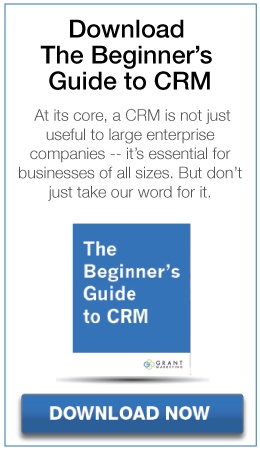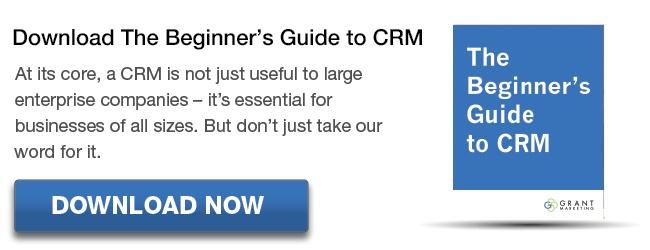Aligning Sales and Marketing Via Your CRM Is a Sales Enablement Best Practice
Got leads? Great! Now what? You might have more than a few in-house sales enablement resources that can help you organize and optimize your next steps. But you probably have one of the best sales enablement tools, quite literally, already at your fingertips—and you don’t realize it. But we’ll discuss that a bit further in this article.
 For now, let’s focus on where you spend your time and resources after getting those leads? And, with those leads in hand, have you:
For now, let’s focus on where you spend your time and resources after getting those leads? And, with those leads in hand, have you:
- Followed-up with the leads and addressed their questions within 1-3 days (or hours) of receiving them?
- Shared any other content or information you suspect they may be interested in—especially if there is behind-the-scenes intel available about their website visit? This includes sending them links to pertinent blogs, case studies, white papers, videos, or infographics.
- Reached out to them via social networks?
- Updated their information in your CRM—qualifying their lead status based the information you have received from them?
- Segmented them into a list so you can easily send them additional nurturing information via marketing automation software?
Don’t Just Say No!
How many of these have you said, “No!” to? More than one? We thought that might be the case. We know you are busy—lead time crunches that have you going 100 mph, customer emergencies that require 10 p.m. phone calls—we get it. But, once your current project is shipped and delivered, you have to keep business coming in. You need to have marketing and sales processes that work together—and perpetually work for you—even as you are chasing down contingencies with today’s production schedule.
Consistent Lead Nurturing Supports Marketing—and Vice Versa
When we talk about sales enablement tools, the CRM provides a one-stop portal for both sales and marketing to guide the sales process to successful fruition. Your lead-nurturing actions should be consistent, helping your marketing efforts remain stable and sustainable. Keep in mind, it’s a vice versa situation when sales and marketing work together successfully—one begets the other—and each supports effective sales enablement practices. Either way, whether or not you have a marketing plan, you need to assess your current situation.
Let’s Back It Up a Bit
Are sales and marketing working together at your company? Truly? Do you communicate regularly and does your sales team provide marketing with informative details that help form the basis for blogs and case studies? Is marketing well aware of the sales goals and prepared to deliver its share of leads—qualified leads, that is—so that the sales team can make its numbers? Is each team aware of its responsibilities to help reach the overall business goals of the company?
Aligning Sales and Marketing
We’re going with the assumption that you have some form of customer relationship management (CRM) software, and perhaps even a marketing software platform to work from. For this discussion, let’s focus on the CRM. When used correctly, a CRM helps your company better understand your prospects and customers, gathers intel on how they interact with your company and brand, while capturing information about the companies they represent, and what the long-term value of your relationship with them might bring. In short—it is the most comprehensive sales enablement tool you have!
Unfortunately, at Grant Marketing, too often we see companies that have a CRM, but are underutilizing it. In fact, according to Cloudswave, 75% of companies have no process of nurturing sales leads, which is your CRM’s primary function: gathering prospects’ intel, analyzing, and interpreting it all so you can respond, in kind, to each prospect’s needs. To add to that stat (thanks, again, Cloudswave), here’s why you want to maximize the power of a CRM:
- Achieve ROI of over 50%: a CRM, on average, returns $5.60 for every $1 spent on it
- Increase customer spend to 20%-40% more on next purchase, once engaged via CRM
- Drive and increase sales by 75%, as reported by sales managers using a CRM
- Increase revenue by 41% per each individual sales representative
- Improve sales conversion rate to over 300%
- Improve customer retention to 27%
- Increase profit margins by over 2%
- Slash marketing costs by 23%
Do We Have Your Attention Yet?
There are some basics that marketing and sales need to be aligned on for ultimate success. Here are a few elements both sales and marketing have to have in their collective scopes:
- How many qualified leads does marketing need to bring in?
- What is the timeframe for these leads?
- Who is keeping track of these leads—and how are they getting dispersed to sales team members?
- Are the leads being qualified?
- Are their lifecycles being documented in the CRM?
So, Where to Start? Draft an SLA
Many companies find that using a service level agreement (SLA) between sales and marketing helps align their collective efforts towards overall business goals. Our marketing software platform partner, HubSpot, provides these five guidelines in establishing an SLA:
- Run a closed loop analysis on your historical inbound lead segments. Calculate the profitability of each segment.
- Classify profitable lead segments as “workable leads,” which are ready for sales. Filter out and/or nurture “non-workable leads.”
- Determine the number of “workable leads” per sales rep, per month, that marketing is accountable for. This metric becomes your marketing SLA.
- Define the number and frequency of attempts that sales will make against each “workable lead.” This metric becomes your sales SLA.
- Automate the daily monitoring of the process. Key metrics to monitor are:
- “Workable leads” produced per sales rep, month-to-date
- Attempts per “workable lead”
- Connect rate per “workable lead”
- Conversion rate to forecasted pipeline per “workable lead”
It’s a Lot, Right?
Yes, using a CRM can sound intimidating to small- and mid-sized businesses. After all, if your company only has a handful of customers, why do you need a dedicated process or system to keep track of them? And when do you find the time?
At its core, a CRM is not just useful to large enterprise companies—it’s essential for businesses of all sizes. But don’t just take our word for it, take a look at a larger, practical discussion of what to look for—and get out of—a properly utilized CRM for your business. Download The Beginner’s Guide to CRM now to stay informed on how it will work for you.



